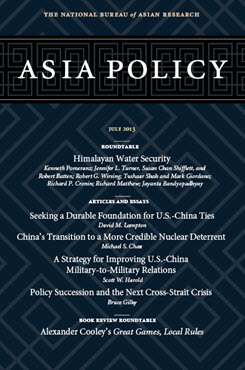Himalayan Water Security
A South Asian Perspective
This is one of seven essays in the roundtable “Himalayan Water Security: The Challenges for South and Southeast Asia.”
South Asia has emerged during recent decades as a major theater of tension and conflict around shared rivers. The region is made up of predominantly rural, poor, and agrarian societies. While in recent years India has been showcased as an emerging economic power, the benefits of Indian economic growth have mainly been concentrated in the southern and western areas. Rural populations in eastern India, Nepal, Pakistan, and Bangladesh continue to have a high concentration of poverty. Persistent agrarian poverty has heightened tension over shared rivers. Concern is also growing among South Asian states that China’s quietly but rapidly expanding dam-building activity in the Himalayan region will increase political tensions in South Asia, potentially leading to conflict.
This essay explores the myriad sources of water-related tensions between India and Pakistan in the Indus Basin and between India and Nepal and Bangladesh in the Ganges Basin. The essay first reviews the nature and sources of tensions among these South Asian neighbors. It then discusses newly emerging concerns about the potential impact of Chinese activities in Tibet on the lower riparian states in South Asia.
The Importance of Water Sharing
Although water wars rarely, if ever, take place between nation-states, water can play an important role in broader political conflict and tensions. Few regions in the world are home to as much interstate tension as South Asia. Pakistan and India were born out of war, and relations are still strained today with even simple transport and trade links severely restricted. Despite the fact that India helped Bangladesh gain its independence, the two countries still have problems, including sharing the waters of the Ganges, Teesta, and other rivers. Overarching all these disputes is the perception of India as the regional hegemon. India’s actions on water issues are thus often viewed by its neighbors with suspicion. Adding ominously to this mix is China’s growing use of eastern Himalayan waters.
Despite these tensions, water forces the nations of South Asia to interact with each other. Nearly all the water in Pakistan, Nepal, Bangladesh, and Bhutan comes from a river shared with at least one other South Asian state. Even in India, where the large Deccan Plateau is hydrologically removed from the rest of the subcontinent, over 30% of water resources are shared. This water is crucial for lives and livelihoods in South Asia. The region is among the most populated in the world, with densities ranging from less than 300 people per square kilometer in the west of South Asia to over 1,000 in Indian Bihar and Bangladesh. While India has been recognized as an emerging economic power, it, like the region as a whole, remains predominantly rural, poor, and agrarian. The Ganges-Brahmaputra-Meghna Basin covering eastern India, Nepal, and Bangladesh has been dubbed South Asia’s “poverty square,” with substantially more people below the dollar-per-day poverty line than in all the countries of sub-Saharan Africa combined. [1] The fruits of much of South Asia’s growth have been in southern and western Indian towns and cities—those generally not supplied by transboundary waters.
Obstacles to Water Sharing
Challenges in the west. When India and Pakistan were formed in 1947, the new boundary cut across long-established irrigation systems and the Indus tributaries that fed them. In 1960 the World Bank facilitated the signing of the Indus Water Treaty (IWT) between the two countries, under which India, as the upper riparian, ceded 80% of Indus waters to Pakistan (approximately 220 billion cubic meters) and kept the remaining 20% for its northwestern plains. While substantial tensions remain, the IWT has survived half a century and three wars between the neighbors. Islamabad remains understandably concerned that New Delhi might use water as a political tool and has challenged every move by India to undertake even IWT-approved run-of-the-river hydropower generation projects. These use flowing water merely to run turbines without reducing supplies to downstream users. General Ashfaq Kayani of Pakistan has often cited water as the justification for his India-centric military stance. [2] In India, too, there is growing doubt, especially in Jammu and Kashmir, about former prime minister Jawaharlal Nehru’s generosity in committing, for all time to come…
[1] World Bank, World Development Indicators 2009 (Washington, D.C.: World Bank, 2009).
[2] “Unquenchable Thirst,” Economist, November 19, 2011, http://www.economist.com/node/21538687.
About Asia Policy
Asia Policy is a peer-reviewed scholarly journal presenting policy-relevant academic research on the Asia-Pacific that draws clear and concise conclusions useful to today’s policymakers. Asia Policy is published quarterly in January, April, July, and October and accepts submissions on a rolling basis. Learn more


